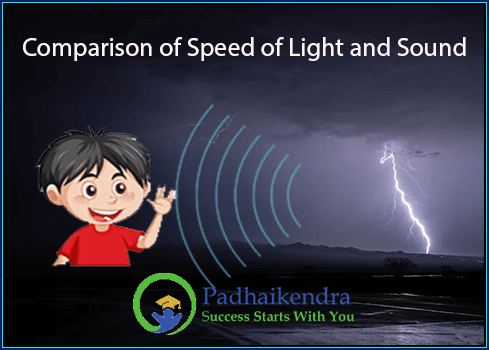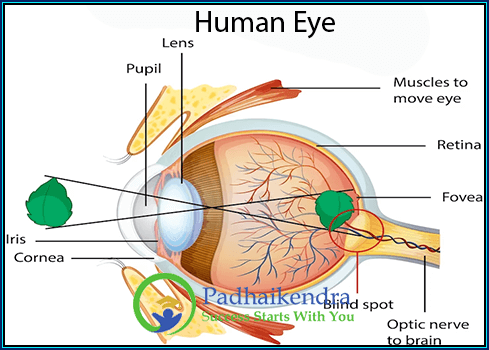Comparison between the speed of Light and Sound
Sound and light are both forms of wave energy, but they propagate differently and have distinct speeds.
 In a typical scenario, light waves travel much faster than sound waves. The speed of light in a vacuum is approximately 299,792 kilometers per second (km/s). In comparison, the speed of sound depends on the medium through which it travels. For example, in dry air at room temperature, the speed of sound is around 343 meters per second (m/s) or approximately 1,235 kilometers per hour (km/h).
In a typical scenario, light waves travel much faster than sound waves. The speed of light in a vacuum is approximately 299,792 kilometers per second (km/s). In comparison, the speed of sound depends on the medium through which it travels. For example, in dry air at room temperature, the speed of sound is around 343 meters per second (m/s) or approximately 1,235 kilometers per hour (km/h).
Due to this significant difference in speeds, we can observe instances where light reaches our eyes before we hear the corresponding sound. For example, when we see a distant fireworks display, we first see the light produced by the fireworks and then hear the sound a short time later. The delay between sight and sound is due to the disparity in speeds between light and sound.
 It’s important to note that the speed of sound can vary depending on the properties of the medium it travels through. For instance, sound waves travel faster through denser materials, such as water or solids, compared to gases like air. In such cases, the speed of sound is significantly higher than in air.
It’s important to note that the speed of sound can vary depending on the properties of the medium it travels through. For instance, sound waves travel faster through denser materials, such as water or solids, compared to gases like air. In such cases, the speed of sound is significantly higher than in air.
Light waves generally travel faster than sound waves, resulting in instances where we see something before we hear it. The speed of light in a vacuum is much higher than the speed of sound, which is dependent on the medium through which it propagates.
Speed of Light and Speed of Sound FAQs
The speed of light is significantly faster than the speed of sound. In a vacuum, light travels at a speed of approximately 299,792 kilometers per second (km/s), whereas sound travels at a much slower speed of about 343 meters per second (m/s) in dry air at 20 degrees Celsius.
The speed of light is faster because light is an electromagnetic wave that doesn't require a medium to propagate. It can travel through empty space. On the other hand, sound is a mechanical wave that requires a medium, such as air, water, or solids, to propagate. The presence of a medium slows down the speed of sound.
The speed difference between light and sound plays a crucial role in our perception of events. Since light travels faster, we see objects in real-time, almost instantaneously. Sound, however, travels more slowly, so we hear sounds with a slight delay, especially over long distances. For example, during a lightning storm, we see the lightning before we hear the thunder due to the speed difference.
The speed of light remains constant in a vacuum, as determined by the fundamental properties of space and time. However, light can travel slower when passing through different materials, such as water or glass. In contrast, the speed of sound can change depending on the properties of the medium it is traveling through. For instance, sound travels faster in denser mediums, such as solids, compared to gases.
The speed of light is vital in various fields, including telecommunications, astronomy, and physics. It enables us to transmit information rapidly over long distances, powers technologies like fiber optics, and allows us to explore distant celestial objects. The speed of sound is utilized in applications such as sonar systems, ultrasound imaging, and music production, where understanding the propagation and behavior of sound waves is essential.
Yes, there are situations where light and sound can be perceived simultaneously, especially when the source of both is in close proximity. For example, when watching a live concert, we see the performers and hear the music synchronously because the sound and light waves generated by the stage are close enough to arrive at our senses at approximately the same time.
The speed difference between light and sound has significant implications for astronomical observations. Astronomers use this difference to measure vast distances in space. For instance, when observing a supernova explosion, they record the time delay between the visible light reaching Earth and any associated sound waves. By calculating this delay, they can estimate the distance to the object and gain insights into its properties.
 In a typical scenario, light waves travel much faster than sound waves. The speed of light in a vacuum is approximately 299,792 kilometers per second (km/s). In comparison, the speed of sound depends on the medium through which it travels. For example, in dry air at room temperature, the speed of sound is around 343 meters per second (m/s) or approximately 1,235 kilometers per hour (km/h).
In a typical scenario, light waves travel much faster than sound waves. The speed of light in a vacuum is approximately 299,792 kilometers per second (km/s). In comparison, the speed of sound depends on the medium through which it travels. For example, in dry air at room temperature, the speed of sound is around 343 meters per second (m/s) or approximately 1,235 kilometers per hour (km/h). It’s important to note that the speed of sound can vary depending on the properties of the medium it travels through. For instance, sound waves travel faster through denser materials, such as water or solids, compared to gases like air. In such cases, the speed of sound is significantly higher than in air.
It’s important to note that the speed of sound can vary depending on the properties of the medium it travels through. For instance, sound waves travel faster through denser materials, such as water or solids, compared to gases like air. In such cases, the speed of sound is significantly higher than in air.




